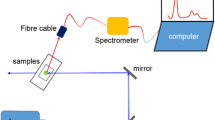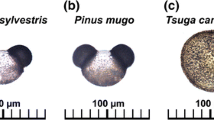Abstract
Spore chemistry is at the centre of investigations aimed at producing a proxy record of harmful ultraviolet radiation (UV-B) through time. A biochemical proxy is essential owing to an absence of long-term (century or more) instrumental records. Spore cell material contains UV-B absorbing compounds that appear to be synthesised in variable amounts dependent on the ambient UV-B flux. To facilitate these investigations we have developed a rapid method for detecting variations in spore chemistry using combined thermochemolysis gas chromatography-mass spectrometry and micro-Fourier transform infrared spectroscopy. Our method was tested using spores obtained from five populations of the tropical lycopsid Lycopodium cernuum growing across an altitudinal gradient (650-1981 m a.s.l.) in S.E. Asia with the assumption that they experienced a range of UV-B radiation doses. Thermochemolysis and subsequent pyrolysis liberated UV-B pigments (ferulic and para-coumaric acid) from the spores. All of the aromatic compounds liberated from spores by thermochemolysis and pyrolysis were active in UV-B protection. The various functional groups associated with UV-B protecting pigments were rapidly detected by micro-FTIR and included the aromatic C?C absorption band which was exclusive to the pigments. We show increases in micro-FTIR aromatic absorption (1510 cm−1) with altitude that may reflect a chemical response to higher UV-B flux. Our results indicate that rapid chemical analyses of historical spore samples could provide a record ideally suited to investigations of a proxy for stratospheric O3 layer variability and UV-B flux over historical (century to millennia) timescales.
Similar content being viewed by others
References
J. Rozema, A. J. Noordijk, R. A. Broekman, B. M. van Beem, (Poly)phenolic compounds in pollen and spores of Antarctic plants as indicators of solar UV-B Plant Ecol. 2001 154 11.
J. Rozema, R. A. Broekman, P. Blokker, B. B. Meijkamp, N. de Bakker, N. J. van de Staaij, A. van Beem, F. Ariese and S. M. Kars, UV-B absorbance and UV-B absorbing compounds (para-coumaric acid) in pollen and sporopollenin: the perspective to track historic UV-B levels J. Photochem. Photobiol., B 2001 62 108–117.
P. Boelen, M. K. de Boer, N. V. J. de Bakker and J. Rozema, Outdoor studies on the effects of solar UV-B on bryophytes: overview and methodology Plant Ecol. 2006 182 137–152.
J. Rozema, P. Boelen, B. Solheim, M. Zielke, A. Buskens, M. Doorenbosch, R. Fijn, J. Herder, T. Callaghan, L. O. Bjorn, D. G. Jones, R. Broekman, P. Blokker, W. van de Poll, Plant Ecol. 2006 182 121–135.
J. C. Farman, B. G. Gardiner and J. D. Shanklin, Large losses of total ozone in Antarctica reveal seasonal interaction Nature 1985 315 207–210.
J. Rozema, B. van Geel, L. O. Björn, J. Lean and S. Madronich, Towards solving the UV puzzle Science 2002 296 1621–1622.
T. A. Day and P. J. Neale, Effects of UV-B radiation on terrestrial and aquatic primary producers Annu. Rev. Ecol. Syst. 2002 33 371–396.
P. S. Searles, S. D. Flint and M. M. Caldwell, A meta-analysis of plant field studies simulating stratospheric ozone depletion Oecologia 2001 127 1–10.
C. S. Cockell and J. Knowland, Ultraviolet radiation screening compounds Biol. Rev. 1999 74 311–345.
K. K. Newsham, A. Hodgson, A. W. A. Murray, H. J. Peat, R. I. Lewis Smith, Response of two Antarctic bryophytes to stratospheric ozone depletion Glob. Change Biol. 2002 8 972–983.
C. V. Giordano, T. Mori, O. E. Sala, A. L. Scopel, K. K. Caldwell and C. L. Ballare, Functional acclimation of solar UV-B radiation in Gunnera magellanica, a native plant species of southernmost Patagonia Plant, Cell Environ. 2003 26 2027–2036.
J. M. Challinor, Review: the development and applications of thermally assisted hydrolysis and methylation reactions J. Anal. Appl. Pyrolysis 2001 61 3–34.
P. Blokker, D. Yeloff, P. Boelen, R. A. Broekman and J. Rozema, Development of a proxy for past surface UV-B irradiation: a thermally assisted hydrolysis and methylation py-GC/MS method for the analysis of pollen and spores Anal. Chem. 2005 77 6026–6031.
R. McKenzie, G. Bodeker, G. Scott, J. Slusser and K. Lantz, Geographical differences in erythemally-weighted UV measured at mid-latitude USDA sites Photochem. Photobiol. Sci. 2006 5 343–352.
D. J. Beerling, Low atmospheric CO2 levels during the Permo-Carboniferous glaciation inferred from fossil lycopsids Proc. Natl. Acad. Sci. USA 2002 99 12567–12571.
D. H. Williams and I. Fleming, Spectroscopic methods in organic chemistry, 1980, McGraw-Hill, London.
P. G. Rouxhet, P. L. Robin and G. B. Nicaise, Characterisation of kerogens and their evolution by infrared spectroscopy, in Kerogen, ed. B. Durand, Editions Technip, Paris, 1980, pp. 163–190.
J. W. de Leeuw and C. Largeau, A review of macromolecular organic compounds that comprise living organisms and their role in kerogen, coal and petroleum formation, in Organic Geochemistry: Principles and Applications, eds M. H. Engel, and S. A. Macko, Plenum Press, New York, 1993, pp. 23–72.
B. L. Yule, S. Roberts and J. E. A. Marshall, The thermal evolution of sporopollenin Org. Geochem. 2000 31 859–870.
P. Blokker, P. Boelen, R. Broekman and J. Rozema, The occurrence of p-coumaric acid and ferulic acid in fossil plant materials and their use as UV-proxy Plant Ecol. 2006 182 197–207.
N. D. Paul, D. Gwynn-Jones, Ecological roles of solar UV radiation: towards an integrated approach Trends Ecol. Evol. 2003 18 48–65.
E. W. Tegelaar, J. W. de Leeuw, S. Derenne and C. Largeau, A reappraisal of kerogen formation Geochim. Cosmochim. Acta 1989 53 3103–3106.
Author information
Authors and Affiliations
Corresponding author
Rights and permissions
About this article
Cite this article
Watson, J.S., Sephton, M.A., Sephton, S.V. et al. Rapid determination of spore chemistry using thermochemolysis gas chromatography-mass spectrometry and micro-Fourier transform infrared spectroscopy. Photochem Photobiol Sci 6, 689–694 (2007). https://doi.org/10.1039/b617794h
Received:
Accepted:
Published:
Issue Date:
DOI: https://doi.org/10.1039/b617794h




